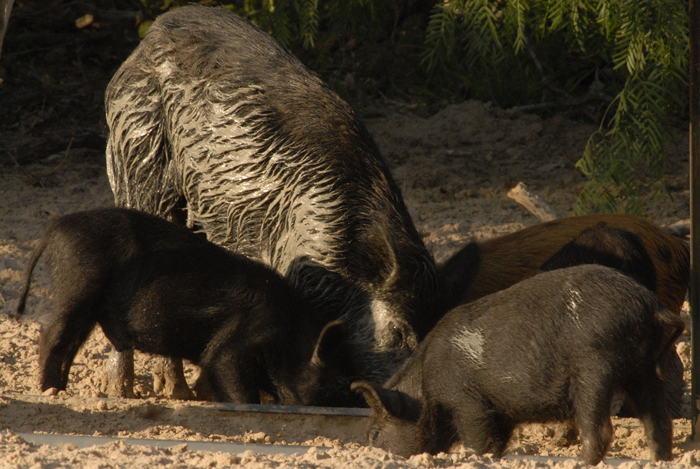by John Jefferson
It’s Christopher Columbus’ fault. Hernando de Soto’s, too. They and other early day explorers brought hogs to America. I’m not advocating destroying history or public statuary, but they’re the ones who started all this, although it probably seemed like a good idea at the time.
The “all this” referred to above means the fact that feral hogs nowadays run wild and raise havoc in 253 of Texas’ 254 counties. There are estimated to be six million of these porkers in America, and over half of them haunt the Texas landscape.
What’s so haunting about them? Well, they do a lot of their dirty work under cover of darkness, and that includes crimes against agriculture, structures, equipment, fences, and water sources. The sow pictured had been swimming and wallowing in mud and possibly dung. Wanta drink out of that spring?
Most crop damage they do isn’t just for feeding, either. Trampling and soil damage from rooting and wallowing take the largest toll.
A 2019 estimate indicates that the ANNUAL loss to agriculture in Texas is approximately $118.8 million! But it’s not just a farm and ranch problem. Researchers conservatively estimate pig damage in vehicle collisions to be $36 million a year in America. Hitting a hog with one wheel usually causes a turnover.
And the problem is increasing. In South Texas, adult and sub-adult sows average 1.57 litters a year, delivering four to six piglets.
Mountain lions, bobcats, coyotes, eagles, alligators, and bears kill an insignificant number annually. Humans eliminate the most through hunting, trapping, and auto collisions, but the combined predation obviously isn’t controlling the rampant population explosion.
The Texas Agriculture Commissioner proposed legalizing “warfarin”, a poison that was lethal to hogs, a few years ago as a population control method. But when the public realized warfarin’s unintended consequence of killing other non-target wildlife species, opposition became overwhelming. Some wildlife could take the poison directly and die. Others could eat poisoned hogs and get a lethal dosage. That was entirely unacceptable. But an alternative is being considered.
According to an article by an ag extension agent with Texas A&M AgriLife Extension Service that appeared in the Denton Record-Chronicle, discussions have begun to consider clearing legislative barriers to using another poison called “sodium nitrate”. I was unable to contact sources at the Capitol for verification, but it doesn’t sound like bills have been filed, yet. The 60-day deadline for free-filing of bills usually falls about March 10, so time is a factor.
Most informed people agree that hog control is desperately needed.
But more research concerning sodium nitrate’s effects would help this medicine go down better with public opinion. The article reported that feeders which only opened for hogs seemed successful.
Sodium nitrate and its effect on humans is still being evaluated by the Environmental Protection Agency. But at least work is beginning on a solution.
As my long-time friend, Harold Stone, with the Fame Bureau, said, “There’s no way we can hunt ourselves out of this (hog) problem.
JJ





